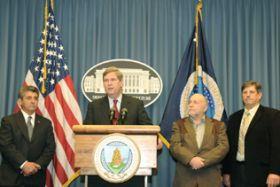
Agriculture Secretary Tom Vilsack has announced the USDA will be delivering its first actions implementing the US$28bn provided in the American Recovery and Reinvestment Act of 2009 (Recovery Act).
“President Obama responded extraordinarily to a crisis unlike any since the Great Depression and his efforts and that of the USDA will have a significant impact not only in rural communities but in communities across the country struggling with today's tough economic times,” Mr Vilsack said in a statement. “Implementation of programs in the act will help stimulate local economies, create jobs as well as protect and restore the environment.”
Funding will help rebuild and revitalize rural communities as well as help stimulate local economies and create jobs throughout the US.
Specifically;
* The Farm Service Agency (FSA) will use immediately $145 million of the $173 million provided in the Recovery Act for its Direct Operating Farm Loan Program, which will give 2,042 farmers – almost 50% are beginning farmers and 10% are socially disadvantaged producers - direct loans from the agency. These loans will be used to purchase items such as farm equipment, feed, seed, fuel and other operating expenses and will stimulate rural economies by providing American farmers funds to operate. Currently, farmers are struggling with the high costs of running family farms, seriously affecting beginning and socially disadvantaged producers.
* USDA Rural Development Agency will initially provide nearly 10,000 rural families with $14.9 million ($1.17 billion in loan guarantees) for homeownership financing, creating or saving more than 5,000 jobs.
* USDA Rural Development will also release funding for more than $400 million in pending applications for Water and Waste grants and $140 million in pending applications for Water and Waste Direct Loans. Rural Development expects nearly 13,000 jobs will be created by 400 water and wastewater projects.
* The Forest Service has released almost $100 million of the $1.15 billion for projects in the Recovery Act. The stimulus funding will be used for hazardous fuels reduction, forest health protection, rehabilitation and hazard mitigation activities on federal, state and private lands. Over 1,500 jobs will be created through shovel ready projects that will be released this week for urban youth and individuals involved in urban forestry, restoration projects fire prevention, roads, bridges, buildings and recreation facilities.
* The Natural Resources Conservation Service (NRCS) will release up to $145 million provided in the Recovery Act to restore frequently flooded land to its natural state; create jobs in rural communities nationwide when landowners establish these floodplain easements; as well as restore and protect an estimated 60,000 acres of flood-prone lands nationwide through the floodplain easement component of its Emergency Watershed Protection Program. Signups for the easements will be held from March 9 – March 27 nationwide.
* NRCS will release $80 million of the $145 million for watershed projects this week. Through the Watershed Protection and Flood Prevention Operations Program funded projects will improve fish and wildlife habitat and create or restore wetlands.
* NRCS also will release $50 million this week for rehabilitating aging watershed structures to protect lives and property and public infrastructure. Over 2,100 jobs directly related to NRCS Recovery Act funding are estimated in the engineering and biological fields, additional specialized equipment operators, construction crews and many other diversified skilled laborers.
* The Recovery Act provides a 13.6 percent increase in the monthly Supplemental Nutrition Assistance Program (SNAP) benefit for recipients, or roughly $80 per family per month. The SNAP program currently serves over 31 million people each month and the influx of funding will not only help those struggling during these tough economic times but stimulate local economies. It's estimated that for every five dollars spent through SNAP, $9.20 of local economic activity is generated. This benefit increase will begin to be provided to recipients on April 1, 2009. In addition, ARRA provides nearly $300 million to help states administer SNAP. The first $145 million will be released this month to assist States in responding to increased need.
* An additional $5 million in funding is provided for the Food Distribution Program on Indian Reservations (FDPIR) for facility improvements and equipment upgrades. This is in addition to the over $114 million we will spend on food distribution on Indian reservations this year. This program provides a vital service. Reservations and tribal lands are often remote with limited service from grocery stores. It provides commodity foods to low-income households, including the elderly, living on Indian reservations, and to Native American families residing in designated areas near reservations and in the State of Oklahoma. Currently, there are approximately 243 tribes receiving benefits under the FDPIR through 98 ITOs and 5 State agencies.
* In addition, the Recovery Act provides additional funding for the Emergency Food Assistance Program. Through this program, USDA provides commodities and administrative funds to states for further distribution to local organizations that assist the needy, including food banks, food pantries, and soup kitchens. The first $25 million to support administrative functions will be distributed in March.
More information about USDA’s efforts regarding the Recovery Act is available at <www.usda.gov/recovery> . More information about the Federal government’s efforts on the economic stimulus is available at <www.recovery.gov> .



